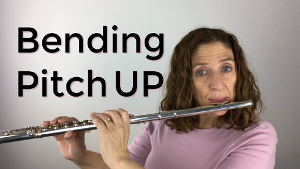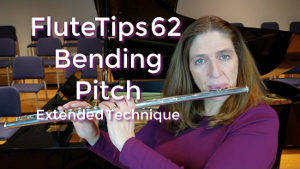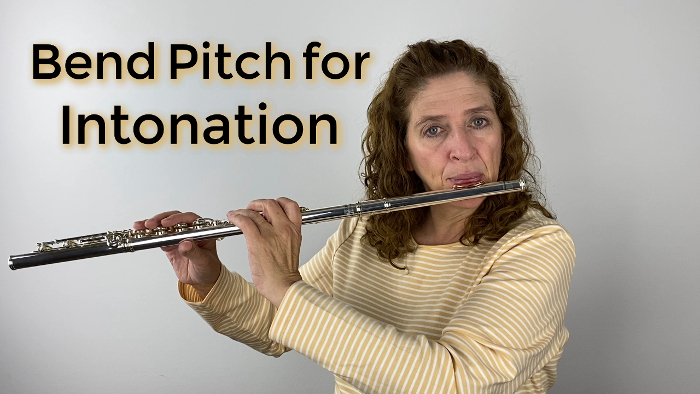We all have intonation problems, and they can occur at the worst times where you feel like you’ve been playing in tune and then suddenly, you’re out of tune. And that might be because the people you’re playing with are different and you don’t understand their intonation, the group you’re playing with altogether, the band or the orchestra. But intonation is a problem and when you’re playing with a piano or you’re playing with your friend, it’s just intonation. We all must work on it, and we all have to work on it all the time.
So, let’s talk about some tricks that you can use to really work on how to get in tune. Now, the first thing that we have is pulling your head joint in and out. So, when they play the tuning notes and you match that tuning note, you’re going to match it with your head joint going up or down.
I have my younger kids think that the way they get in tune, once they do that, then they’re in tune forever. That that’s it, that that’s the bottom line. I’ve got it out. I’m in tune with the tuner on a or with the trombones or whatever. And so that’s it. I don’t have to do anything else.
But we all know of the more mature flutists, that we must work on intonation on every note all the time because every note can be different. Every note is different with the different instruments we play with. If I play with an oboe right now, I have a group of an oboe and a bassoon, and their intonation issues are different from my intonation issues. And so, I have to be adjusting and thinking and listening all the time. But if you’ve got this in the right spot, then how do you fix intonation while you’re playing?
Well, one of the ways to do it is to bend the pitch. And by bending the pitch, you bring the pitch up or you bring the pitch down. So, it’s worthwhile to work on bending your pitch and how big of a bend can you get in your pitch? And then when you need it, you have that tool ready.
So, when we’re talking bending pitch, we’re not really saying roll in because I’ve seen that in bands in my elementary students with their band directors. So, they’ll say, Okay, just roll in. Sometimes they’re just desperate to get their bands to play in tune, and I don’t fault them for that. Just tell your flutist to, to put their head down or roll it in right, either or roll it because it will do what they need it to do. But that’s not really how we want to change our pitch. We want to practice it by having our airstream move right without our head. Because if our head moves, we’re really changing our tone and it doesn’t become a good tone, we still want to keep that good sound. So, if I practice bending the pitch, let me practice with my embouchure, I’m going to use my embouchure to do that.
Now I bent it, was there a little movement of my head? I’m sure there is a movement of my head and my eyebrows definitely have to go up that just part of it. You have to have your eyebrows go up and down when you play. If I move by embouchure sure I can really bring the pitch down a lot. It’s a little bit harder. You don’t get quite as much forward momentum by going up, but it still does go up and it can go up a little higher. Now, if I really need to go up even higher than that, I want to really lift my embouchure up out of that hole as much as I can to get in tune with whoever I have to get in tune with. Sometimes we have that problem in our highest octave is that’s, you know, our third octaves can either be really sharp or really flat, and we need to remove our embouchure in order to do that. So, practice bending. The more you practice it, the better you’ll get at it and the better you’ll get it. Keeping the tone really nice. It’s really hard not to do it without your eyebrows going up too.
I’m just moving my jaw back and forth. I’m moving that airstream. I want the airstream to move not my head. If I need to. I might do a little movement, but not a lot. I certainly don’t want to, when I move my head all the way down, I cover more embouchure hole and I’m not trying to do that. All I want to do is move my airstream and see how it’s cut on this outer edge. That’s what’s going to give me better intonation on the spur of the moment. Now, yes, you’re going to move your head joint in and out because that’s what’s necessary at the beginning to get in tune your major intonation issue and then all the minor ones that come along. You’re going to do it by bending your pitch. So then if I play just a G and I realize I’m a little bit sharp with now the oboe next to me, I’ve just lowered it. Now I’m in tune, but I haven’t changed my tone. It’s just a little bit of a difference. So, I still have the good tone that I had where, whereas if I move my head or a roll in, the whole tone sounds flat. It is not only that you’re lowering it, but also just there’s a muffled sound, in that the nice bright sound that you had goes away.
So that is what I would recommend you do to work on intonation within your ensemble, to work on every note, not to move the head a lot. We’re not going to be bobbing up and down, but to move your jaw, move your embouchure, your upper lip now going over your bottom or backing up a little bit as you even the lips out to bring in the airstream up a little higher. It’s all about manipulating that airstream.
So, practice bending pitch and you’ll really revolutionize your intonation issues and you’ll not have as many if you can do that.
Have fun!
DoctorFlute
Watch me demonstrate this idea:
Bending Pitch to Work on Intonation – FluteTips 167

FluteTips 86 Bending Your Pitch UP

FluteTips 62 Bending Pitch Extended Flute Technique

Autumn in Homeland for Solo Flute by Anže Rozman – Angela McBrearty Flute

